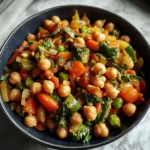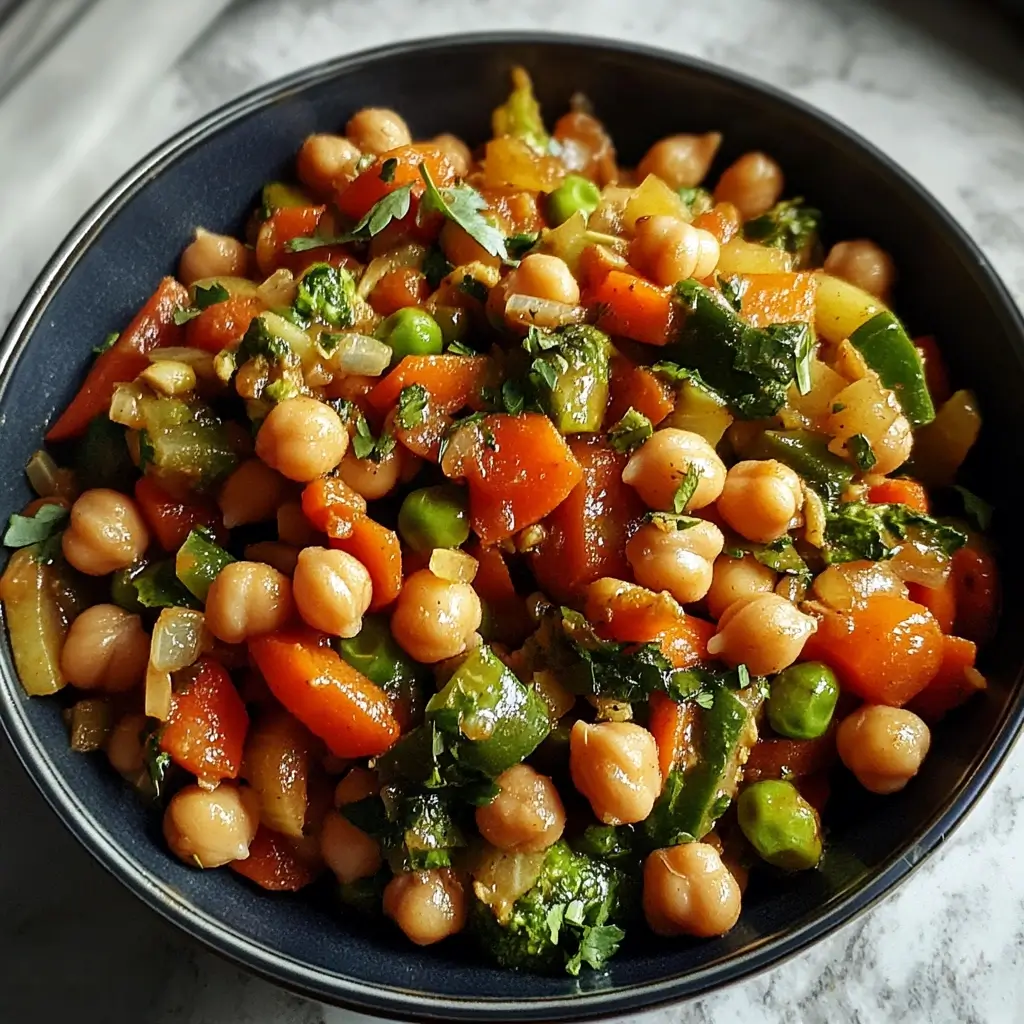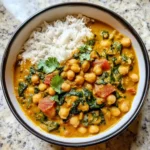It started, as many weeknight dinners do, with a rummage through the fridge. A half-empty can of chickpeas, some slightly weary-looking broccoli, a lone bell pepper, and the usual suspects – onion, garlic, ginger. The pantry offered rice noodles and the promise of a quick sauce. Honestly, I wasn’t expecting culinary fireworks, just sustenance. But what emerged from the wok that evening was a revelation! This Chickpea and Veggie Stir-Fry wasn’t just fast and convenient; it was genuinely delicious. The chickpeas became slightly crisp on the outside while staying tender within, soaking up the savory, tangy sauce beautifully. The vegetables retained a perfect crisp-tender bite, bursting with freshness. Even my pickiest eater, usually skeptical of anything heavily featuring vegetables, went back for seconds, commenting on the “surprisingly good crunchy bits” (the chickpeas!). It instantly became a staple in our rotation – a testament to how simple ingredients, treated well, can create something truly satisfying, healthy, and packed with flavor. It’s proof that plant-based eating can be incredibly vibrant and that a fantastic meal doesn’t require hours of effort or exotic ingredients. This recipe is my go-to for a reason: it’s reliable, adaptable, nutritious, and, most importantly, consistently wins rave reviews at the dinner table.
Ingredients for the Ultimate Chickpea and Veggie Stir-Fry
This recipe relies on fresh produce and pantry staples to create a vibrant and flavorful dish. Ensure your vegetables are chopped uniformly for even cooking.
For the Stir-Fry:
- 1 tbsp Sesame Oil: Toasted sesame oil adds a distinct nutty aroma, perfect for starting the stir-fry.
- 1 tbsp Avocado Oil (or other high-heat oil): Used for sautéing; choose an oil with a high smoke point like avocado, grapeseed, or canola.
- 1 Medium Yellow Onion, thinly sliced: Forms the aromatic base, adding sweetness when sautéed.
- 2-3 Cloves Garlic, minced: Essential for its pungent flavor; mince finely to distribute evenly.
- 1 tbsp Fresh Ginger, grated or minced: Provides a warm, zesty kick that complements the other ingredients.
- 1 Red Bell Pepper, deseeded and sliced: Adds sweetness, vibrant color, and Vitamin C.
- 1 Yellow or Orange Bell Pepper, deseeded and sliced: Offers a slightly different sweetness profile and more color variety.
- 1 Large Head of Broccoli, cut into small florets: Provides texture, earthy flavor, and numerous nutrients. Ensure florets are bite-sized.
- 1 Medium Carrot, julienned or thinly sliced: Adds sweetness, crunch, and beta-carotene.
- 1 cup Snap Peas or Snow Peas, trimmed: Offer a delightful crispness and fresh green flavor.
- 1 can (15-ounce) Chickpeas, rinsed and thoroughly drained: The star protein! Draining and drying helps them crisp up slightly.
- Optional: 1/2 block (7 oz) Firm or Extra-Firm Tofu, pressed and cubed: If you want extra protein, pressed tofu stir-fries beautifully alongside the chickpeas.
For the Stir-Fry Sauce:
- 1/3 cup Low-Sodium Soy Sauce (or Tamari for Gluten-Free): The savory, umami backbone of the sauce.
- 2 tbsp Rice Vinegar: Adds a necessary tanginess to balance the savory and sweet notes.
- 1 tbsp Maple Syrup (or Agave Nectar): Provides a touch of sweetness; adjust to your preference.
- 1 tbsp Toasted Sesame Oil: Reinforces the nutty flavor throughout the dish.
- 1 tsp Cornstarch (or Arrowroot Powder): Thickens the sauce slightly, helping it coat the vegetables and chickpeas.
- 1/4 tsp Red Pepper Flakes (optional): Adds a gentle heat; increase or decrease based on your spice tolerance.
- Water or Vegetable Broth (as needed): To adjust sauce consistency if it becomes too thick.
For Garnish (Optional):
- Toasted Sesame Seeds: Adds texture and nutty flavor.
- Sliced Green Onions: Provides a fresh, mild oniony bite.
- Fresh Cilantro Leaves: Adds a bright, herbaceous note.
Step-by-Step Instructions for Perfect Stir-Fry
Follow these steps carefully for a stir-fry where vegetables stay crisp, chickpeas are flavorful, and everything is coated in a delicious sauce. Preparation is key – have all your ingredients chopped and measured before you begin cooking.
- Prepare the Sauce: In a small bowl, whisk together all the sauce ingredients: low-sodium soy sauce (or tamari), rice vinegar, maple syrup (or agave), 1 tbsp toasted sesame oil, cornstarch (or arrowroot powder), and optional red pepper flakes. Ensure the cornstarch is fully dissolved. Set aside.
- Prepare the Chickpeas: Rinse the canned chickpeas thoroughly under cold water. Drain them very well. Pat them completely dry with paper towels or a clean kitchen towel. Removing excess moisture is crucial for preventing sogginess and encouraging a slight crisping during cooking. If using tofu, ensure it’s well-pressed and cubed.
- Heat the Wok/Skillet: Place a large wok or a large, heavy-bottomed skillet over medium-high heat. Allow it to get properly hot – a drop of water should evaporate instantly. This high heat is essential for achieving the characteristic stir-fry texture.
- Sauté Aromatics: Add the 1 tbsp of avocado oil (or other high-heat oil) to the hot wok. Swirl to coat. Add the sliced yellow onion and stir-fry for 1-2 minutes until it begins to soften and become translucent.
- Add Garlic and Ginger: Add the minced garlic and grated ginger to the wok. Stir continuously for about 30-60 seconds until fragrant. Be careful not to burn the garlic.
- Cook the Harder Vegetables: Add the firmer vegetables that require longer cooking times, such as the broccoli florets and carrots. Stir-fry for 3-4 minutes, tossing frequently, until they are bright in color and begin to become tender-crisp. Add a tablespoon of water or broth if the pan seems too dry, which helps steam the broccoli slightly.
- Add Softer Vegetables and Chickpeas: Add the sliced bell peppers and snap peas (or snow peas) to the wok. Continue to stir-fry for another 2-3 minutes. Add the drained and dried chickpeas (and cubed tofu, if using). Stir everything together gently, ensuring the chickpeas get heated through, about 1-2 minutes.
- Create a Well and Add Sauce: Push the vegetables and chickpeas to the sides of the wok, creating a well in the center. Give the prepared sauce a quick whisk (as the cornstarch may have settled) and pour it into the center of the wok. Let it bubble and thicken slightly for about 30 seconds.
- Combine and Coat: Toss everything together quickly and thoroughly, ensuring the vegetables and chickpeas are evenly coated with the thickened sauce. Cook for another 1-2 minutes, just until the sauce glazes everything beautifully and the vegetables are perfectly crisp-tender. Avoid overcooking at this stage, as the vegetables will lose their vibrancy and texture.
- Final Touch: Stir in the 1 tbsp of toasted sesame oil for a final burst of nutty aroma. Remove the wok from the heat immediately.
- Serve: Serve the Chickpea and Veggie Stir-Fry hot, garnished with optional toasted sesame seeds, sliced green onions, or fresh cilantro, alongside your choice of base (like rice or noodles).
Understanding the Nutrition Facts
This stir-fry is a powerhouse of nutrients, offering a balanced plant-based meal. Nutritional information is an estimate and can vary based on specific ingredients and quantities used.
- Servings: This recipe typically yields 3-4 servings as a main course.
- Calories per Serving: Approximately 350-450 calories per serving (excluding rice or noodles), depending on the exact amount of oil and optional ingredients like tofu used.
- Protein: Packed with plant-based protein primarily from the chickpeas (and tofu, if added), crucial for muscle repair, satiety, and overall body function. A serving provides a significant portion of daily protein needs.
- Fiber: High in dietary fiber from the chickpeas and abundant vegetables. Fiber aids digestion, helps regulate blood sugar levels, and contributes to feelings of fullness, supporting weight management.
- Vitamins (especially C & A): Rich in Vitamin C from bell peppers and broccoli, which boosts immunity and acts as an antioxidant. Carrots contribute Vitamin A (as beta-carotene), essential for vision and skin health.
- Minerals (Iron & Potassium): Chickpeas provide a good source of plant-based iron, important for oxygen transport. Various vegetables contribute potassium, which helps regulate blood pressure and fluid balance.
- Healthy Fats: Contains unsaturated fats from avocado oil and sesame oil, which are beneficial for heart health, especially when replacing saturated fats.
Quick and Easy Preparation Time
This Chickpea and Veggie Stir-Fry is designed for speed and efficiency, making it ideal for busy weeknights.
- Total Time: Approximately 30-35 minutes
- Preparation Time: 15-20 minutes (includes washing and chopping vegetables, draining chickpeas, mixing the sauce)
- Cooking Time: 10-15 minutes
The key to the quick cooking time is having everything prepped (“mise en place”) before you start stir-frying. The high heat cooks everything rapidly, preserving the texture and nutrients of the vegetables. Using canned chickpeas significantly cuts down on prep compared to cooking dried chickpeas from scratch.
Delicious Ways to Serve Your Chickpea and Veggie Stir-Fry
This versatile stir-fry pairs wonderfully with various bases and garnishes. Here are some serving suggestions:
- Classic Rice:
- Serve hot over fluffy steamed jasmine rice for a traditional pairing.
- Opt for brown rice for added fiber and a nuttier flavor.
- Basmati rice also works well with its distinct aroma.
- Noodle Night:
- Toss with cooked rice noodles (thin or thick) for a gluten-free noodle bowl experience.
- Serve alongside or mixed with soba noodles (buckwheat) or udon noodles (thick wheat).
- Even whole wheat spaghetti can work in a pinch for a fusion meal.
- Grain Bowls:
- Spoon over cooked quinoa for a complete protein, gluten-free grain bowl.
- Use farro or barley for a chewier, heartier grain base.
- Low-Carb Options:
- Serve over cauliflower rice for a lighter, low-carb alternative.
- Enjoy it alongside zucchini noodles (zoodles).
- Simply eat it on its own for a veggie-packed, protein-rich meal.
- Garnishes and Toppings:
- Mandatory: A sprinkle of toasted sesame seeds adds visual appeal and nutty crunch.
- Freshness: Thinly sliced green onions or chopped fresh cilantro adds brightness.
- Crunch: Add chopped cashews or peanuts for extra texture.
- Heat: Drizzle with sriracha or add extra red pepper flakes for spice lovers.
- Acidity: A small wedge of lime on the side allows diners to add a fresh citrusy zing.
Pro Tips for Elevating Your Stir-Fry Game
Take your Chickpea and Veggie Stir-Fry from good to great with these expert tips:
- Master the Heat: Don’t be afraid of high heat! A properly heated wok or skillet is crucial. It sears the ingredients quickly, creating flavor (wok hei, if using a wok) and preventing the vegetables from steaming and becoming soggy. Keep the ingredients moving constantly.
- Prep Everything First (Mise en Place): Stir-frying is fast. You won’t have time to chop vegetables or mix the sauce once you start cooking. Have every single ingredient prepped, measured, and within easy reach before you turn on the stove.
- Don’t Crowd the Pan: Cook in batches if necessary. Overcrowding the pan lowers the temperature drastically, leading to steaming instead of searing. Ensure ingredients have enough space to make direct contact with the hot surface.
- Uniform Vegetable Cuts: Cut your vegetables into relatively uniform, bite-sized pieces. This ensures they cook evenly and are easy to eat. Slice harder vegetables (like carrots) thinner than softer ones (like bell peppers).
- Dry Your Chickpeas Thoroughly: We can’t stress this enough! Wet chickpeas will splatter and steam, preventing them from getting that slightly crisp exterior. Pat them very dry after rinsing. You can even let them air dry for 15-20 minutes if time allows.
- Sequence Matters: Add ingredients based on their cooking time. Start with aromatics (onion, garlic, ginger), then add harder vegetables (broccoli, carrots), followed by softer vegetables (peppers, snap peas), protein (chickpeas/tofu), and finally the sauce.
- Sauce Consistency Control: Whisk the cornstarch into the cold sauce ingredients before adding it to the hot wok to prevent lumps. If the sauce gets too thick, splash in a little water or vegetable broth. If too thin, let it bubble a bit longer or mix a tiny bit more cornstarch with cold water (a slurry) and stir it in.
- Finish with Sesame Oil: Adding the toasted sesame oil off the heat or right at the very end preserves its delicate nutty flavor and aroma, which can diminish with prolonged high heat cooking.
Frequently Asked Questions (FAQ) about Chickpea Stir-Fry
Here are answers to common questions about making this delicious and healthy stir-fry:
- Can I use different vegetables?
Absolutely! Stir-fries are incredibly versatile. Feel free to substitute or add vegetables based on what you have on hand or prefer. Mushrooms, zucchini, bok choy, baby corn, water chestnuts, green beans, or asparagus would all work well. Just adjust cooking times accordingly (add harder veggies first). - How can I make this recipe gluten-free?
Easily! The main source of gluten is typically soy sauce. Simply substitute the regular soy sauce with certified gluten-free tamari or liquid aminos. Ensure any pre-packaged broths used are also gluten-free. Rice noodles are a great gluten-free serving option. - Can I add a different protein besides chickpeas or tofu?
Yes. While chickpeas are the star, you could add cooked edamame for more green protein. If you’re not strictly vegan/vegetarian, cooked shrimp or thinly sliced chicken/beef (stir-fried separately first and added back at the end) would also work. Adjust sauce seasonings if needed for different proteins. - How do I make it spicier (or less spicy)?
To increase the heat, add more red pepper flakes to the sauce, include some thinly sliced jalapeño or serrano pepper with the aromatics, or serve with sriracha or chili garlic sauce on the side. To make it less spicy, simply omit the red pepper flakes entirely. - Is this recipe suitable for meal prep?
Yes, it’s great for meal prep! Cook the stir-fry as directed and portion it into airtight containers alongside your chosen base (rice, quinoa). Store in the refrigerator for up to 3-4 days. Reheat gently in the microwave or briefly in a skillet. The vegetables might soften slightly upon reheating but will still be delicious. - Can I freeze this stir-fry?
While you can freeze it, the texture of the vegetables (especially peppers and snap peas) might become softer and slightly watery upon thawing and reheating. The chickpeas and sauce freeze well. If freezing, slightly undercook the vegetables. Thaw overnight in the refrigerator before reheating. For best results, consume fresh or meal prep for the fridge. - My sauce seems too thin/thick. How do I fix it?
If the sauce is too thin after adding it, let it simmer and bubble for an extra minute or two to reduce slightly. If it’s still not thick enough, make a small slurry (1 tsp cornstarch mixed with 1 tbsp cold water), stir it in, and simmer briefly until thickened. If the sauce is too thick, simply whisk in a tablespoon or two of water or vegetable broth until it reaches your desired consistency. - Can I use dried chickpeas instead of canned?
Yes, but it requires planning. You’ll need to soak the dried chickpeas overnight (or use a quick-soak method) and then cook them until tender (usually 1-1.5 hours on the stovetop or much faster in a pressure cooker) before proceeding with the recipe. Ensure the cooked chickpeas are well-drained and dried before adding them to the stir-fry. Canned chickpeas offer significant convenience for this quick dish.

Chickpea and Veggie Stir-Fry
- Total Time: 35 minutes
Ingredients
This recipe relies on fresh produce and pantry staples to create a vibrant and flavorful dish. Ensure your vegetables are chopped uniformly for even cooking.
For the Stir-Fry:
- 1 tbsp Sesame Oil: Toasted sesame oil adds a distinct nutty aroma, perfect for starting the stir-fry.
- 1 tbsp Avocado Oil (or other high-heat oil): Used for sautéing; choose an oil with a high smoke point like avocado, grapeseed, or canola.
- 1 Medium Yellow Onion, thinly sliced: Forms the aromatic base, adding sweetness when sautéed.
- 2–3 Cloves Garlic, minced: Essential for its pungent flavor; mince finely to distribute evenly.
- 1 tbsp Fresh Ginger, grated or minced: Provides a warm, zesty kick that complements the other ingredients.
- 1 Red Bell Pepper, deseeded and sliced: Adds sweetness, vibrant color, and Vitamin C.
- 1 Yellow or Orange Bell Pepper, deseeded and sliced: Offers a slightly different sweetness profile and more color variety.
- 1 Large Head of Broccoli, cut into small florets: Provides texture, earthy flavor, and numerous nutrients. Ensure florets are bite-sized.
- 1 Medium Carrot, julienned or thinly sliced: Adds sweetness, crunch, and beta-carotene.
- 1 cup Snap Peas or Snow Peas, trimmed: Offer a delightful crispness and fresh green flavor.
- 1 can (15-ounce) Chickpeas, rinsed and thoroughly drained: The star protein! Draining and drying helps them crisp up slightly.
- Optional: 1/2 block (7 oz) Firm or Extra-Firm Tofu, pressed and cubed: If you want extra protein, pressed tofu stir-fries beautifully alongside the chickpeas.
For the Stir-Fry Sauce:
- 1/3 cup Low-Sodium Soy Sauce (or Tamari for Gluten-Free): The savory, umami backbone of the sauce.
- 2 tbsp Rice Vinegar: Adds a necessary tanginess to balance the savory and sweet notes.
- 1 tbsp Maple Syrup (or Agave Nectar): Provides a touch of sweetness; adjust to your preference.
- 1 tbsp Toasted Sesame Oil: Reinforces the nutty flavor throughout the dish.
- 1 tsp Cornstarch (or Arrowroot Powder): Thickens the sauce slightly, helping it coat the vegetables and chickpeas.
- 1/4 tsp Red Pepper Flakes (optional): Adds a gentle heat; increase or decrease based on your spice tolerance.
- Water or Vegetable Broth (as needed): To adjust sauce consistency if it becomes too thick.
For Garnish (Optional):
- Toasted Sesame Seeds: Adds texture and nutty flavor.
- Sliced Green Onions: Provides a fresh, mild oniony bite.
- Fresh Cilantro Leaves: Adds a bright, herbaceous note.
Instructions
Follow these steps carefully for a stir-fry where vegetables stay crisp, chickpeas are flavorful, and everything is coated in a delicious sauce. Preparation is key – have all your ingredients chopped and measured before you begin cooking.
- Prepare the Sauce: In a small bowl, whisk together all the sauce ingredients: low-sodium soy sauce (or tamari), rice vinegar, maple syrup (or agave), 1 tbsp toasted sesame oil, cornstarch (or arrowroot powder), and optional red pepper flakes. Ensure the cornstarch is fully dissolved. Set aside.
- Prepare the Chickpeas: Rinse the canned chickpeas thoroughly under cold water. Drain them very well. Pat them completely dry with paper towels or a clean kitchen towel. Removing excess moisture is crucial for preventing sogginess and encouraging a slight crisping during cooking. If using tofu, ensure it’s well-pressed and cubed.
- Heat the Wok/Skillet: Place a large wok or a large, heavy-bottomed skillet over medium-high heat. Allow it to get properly hot – a drop of water should evaporate instantly. This high heat is essential for achieving the characteristic stir-fry texture.
- Sauté Aromatics: Add the 1 tbsp of avocado oil (or other high-heat oil) to the hot wok. Swirl to coat. Add the sliced yellow onion and stir-fry for 1-2 minutes until it begins to soften and become translucent.
- Add Garlic and Ginger: Add the minced garlic and grated ginger to the wok. Stir continuously for about 30-60 seconds until fragrant. Be careful not to burn the garlic.
- Cook the Harder Vegetables: Add the firmer vegetables that require longer cooking times, such as the broccoli florets and carrots. Stir-fry for 3-4 minutes, tossing frequently, until they are bright in color and begin to become tender-crisp. Add a tablespoon of water or broth if the pan seems too dry, which helps steam the broccoli slightly.
- Add Softer Vegetables and Chickpeas: Add the sliced bell peppers and snap peas (or snow peas) to the wok. Continue to stir-fry for another 2-3 minutes. Add the drained and dried chickpeas (and cubed tofu, if using). Stir everything together gently, ensuring the chickpeas get heated through, about 1-2 minutes.
- Create a Well and Add Sauce: Push the vegetables and chickpeas to the sides of the wok, creating a well in the center. Give the prepared sauce a quick whisk (as the cornstarch may have settled) and pour it into the center of the wok. Let it bubble and thicken slightly for about 30 seconds.
- Combine and Coat: Toss everything together quickly and thoroughly, ensuring the vegetables and chickpeas are evenly coated with the thickened sauce. Cook for another 1-2 minutes, just until the sauce glazes everything beautifully and the vegetables are perfectly crisp-tender. Avoid overcooking at this stage, as the vegetables will lose their vibrancy and texture.
- Final Touch: Stir in the 1 tbsp of toasted sesame oil for a final burst of nutty aroma. Remove the wok from the heat immediately.
- Serve: Serve the Chickpea and Veggie Stir-Fry hot, garnished with optional toasted sesame seeds, sliced green onions, or fresh cilantro, alongside your choice of base (like rice or noodles).
- Prep Time: 20 minutes
- Cook Time: 15 minutes
Nutrition
- Serving Size: one normal portion
- Calories: 450






